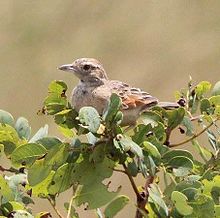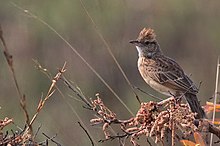The Angola lark (Amirafra angolensis) or Angola bushlark is a species of lark in the family Alaudidae found in southern and central Africa.
| Angola lark | |
|---|---|

| |
| Scientific classification | |
| Domain: | Eukaryota |
| Kingdom: | Animalia |
| Phylum: | Chordata |
| Class: | Aves |
| Order: | Passeriformes |
| Family: | Alaudidae |
| Genus: | Amirafra |
| Species: | A. angolensis
|
| Binomial name | |
| Amirafra angolensis (Barboza du Bocage, 1880)
| |
| Subspecies | |
|
See text | |

| |
| resident range | |

Taxonomy
editThe Angola lark was formerly placed in the genus Mirafra. It is one of three species that were moved to the resurrected genus Amirafra based on the results of a large molecular genetic study by the Swedish ornithologist Per Alström and collaborators that was published in 2023.[2][3]
Three subspecies are recognised:[2]
- A. a. marungensis (Hall, BP, 1958) – southeast DR Congo and southwest Tanzania
- A. a. angolensis (Barboza du Bocage, 1880) – north, west, central Angola
- A. a. antonii (Hall, BP, 1958) – east Angola to south DR Congo and northwest Zambia
Distribution and habitat
editThe range of the Angola lark is sizable, and is found in Angola, Democratic Republic of Congo, Tanzania and Zambia. It is estimated to have a global extent of occurrence of about 170,000 square km.[1] Its natural habitats are subtropical or tropical dry, or seasonally wet, lowland grassland.
References
edit- ^ a b BirdLife International (2016). "Mirafra angolensis". IUCN Red List of Threatened Species. 2016: e.T22717064A94519842. doi:10.2305/IUCN.UK.2016-3.RLTS.T22717064A94519842.en. Retrieved 12 November 2021.
- ^ a b Gill, Frank; Donsker, David; Rasmussen, Pamela, eds. (August 2024). "Nicators, Bearded Reedling, larks". IOC World Bird List Version 14.2. International Ornithologists' Union. Retrieved 10 September 2024.
- ^ Alström, P.; Mohammadi, Z.; Enbody, E.D.; Irestedt, M.; Engelbrecht, D.; Crochet, P.-A.; Guillaumet, A.; Rancilhac, L.; Tieleman, B.I.; Olsson, U.; Donald, P.F.; Stervander, M. (2023). "Systematics of the avian family Alaudidae using multilocus and genomic data". Avian Research. 14: 100095. doi:10.1016/j.avrs.2023.100095.
External links
edit- Compilers: Stuart Butchart, Jonathan Ekstrom (2008). "Angolan Lark - BirdLife Species Factsheet". Evaluators: Jeremy Bird, Stuart Butchart. BirdLife International. Retrieved May 11, 2009.
